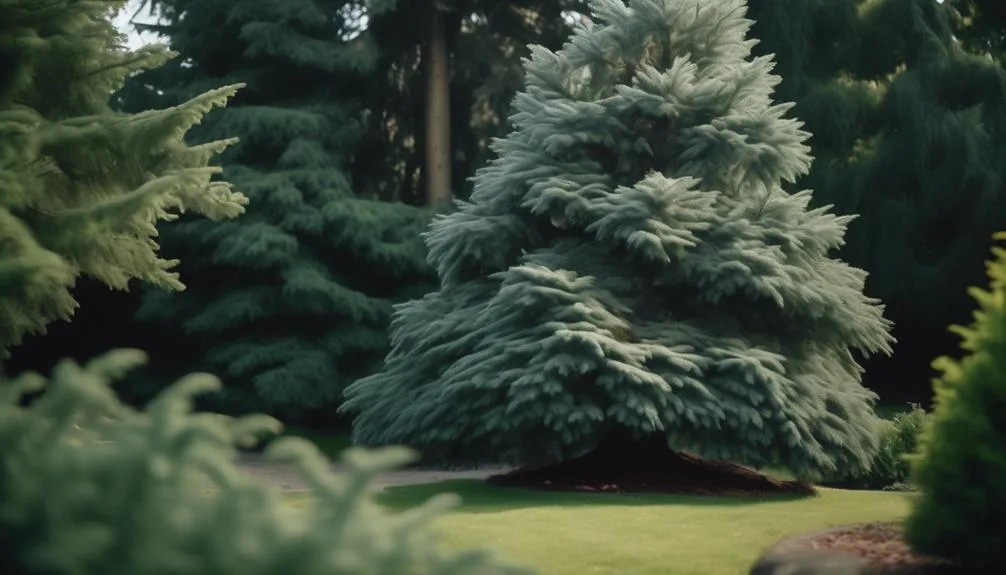Wondering when to trim your spruce trees? It's important to know the best time for pruning to keep them healthy and looking great. Discover the signs that indicate it's time for some tree grooming and learn the best practices for spruce tree trimming.
By understanding when to give those majestic spruces a snip, you can ensure your landscape stays thriving and picturesque.
Optimal Timing for Trimming Spruce Trees
To ensure healthy growth and maintain the desired shape, it's best to trim spruce trees in late winter or early spring before new growth begins.
Proper equipment is crucial for this task. Use sharp, clean pruning shears for small branches and a pruning saw for larger ones.
When trimming, pay attention to the tree's growth patterns. Spruce trees have a natural conical shape, so trim with this in mind.
Be sure to remove any dead, damaged, or diseased branches to promote overall tree health.
Trimming at the right time and using the proper equipment will help your spruce trees thrive and maintain their beautiful form.
Best Season for Spruce Tree Pruning
When considering the best season for pruning your spruce trees, it's important to keep in mind their natural conical shape and growth patterns, ensuring that you maintain their health and desired form. The best time for spruce tree pruning is in late winter to early spring when the trees are still dormant. This period offers several environmental factors that favor the tree's recovery and growth.
Here's why winter pruning is ideal:
- Dormancy: During winter, the tree is dormant, allowing for minimal sap flow and reducing stress on the tree.
- Reduced Disease Spread: Pruning in winter helps minimize the risk of disease spread, as fungal spores are less active.
- Promotes Spring Growth: Winter pruning stimulates new growth in the spring, encouraging healthy development.
- Minimized Stress: Pruning in winter reduces stress on the tree caused by pruning during the active growing season.
Signs That Your Spruce Trees Need Trimming
If your spruce trees exhibit overgrown branches or irregular shape, it's time to consider trimming them for optimal health and aesthetics. When assessing whether your spruce trees need trimming, pay attention to their branch structure and growth patterns. Here are some signs that indicate it's time to trim your spruce trees:
| Signs of Needing Trimming | Description |
|---|---|
| Overgrown Branches | If your spruce trees have branches extending too far, it's time for trimming. |
| Irregular Shape | Trees with uneven growth patterns or irregular shapes may benefit from trimming. |
| Reduced Sunlight Penetration | If the canopy becomes too dense, consider trimming to allow more sunlight to reach the inner branches. |
| Signs of Disease | Trimming can help remove diseased branches and promote overall tree health. |
Regularly assessing these signs will ensure your spruce trees remain healthy and visually appealing.
Tips for Pruning Spruce Trees
For effective pruning of spruce trees, start by identifying and removing any dead, damaged, or diseased branches. This helps improve tree health and promotes new growth.
When pruning spruce trees, consider the following tips:
- Timing: Aim to prune in late winter or early spring to minimize stress on the tree.
- Techniques: Use clean, sharp pruning tools to make precise cuts at a 45-degree angle just beyond the branch collar.
- Consistency: Regularly inspect and prune your spruce trees to maintain their shape and health.
- Caution: Avoid over-pruning, as this can weaken the tree and make it more susceptible to disease and pests.
Following these pruning techniques will help keep your spruce trees healthy and looking their best.
Mistakes to Avoid When Trimming Spruce Trees
To ensure successful trimming of spruce trees, it's important to be mindful of common mistakes that can hinder their health and appearance.
One of the most common mistakes is over-pruning, which can stress the tree and leave it vulnerable to diseases and pests.
Another mistake to avoid is using improper tools, such as dull or dirty pruning equipment, as this can cause damage to the tree and inhibit its growth.
Additionally, failing to follow proper technique, like cutting too close to the trunk or leaving behind stubs, can lead to slow healing and potential entry points for pests and diseases.
It's crucial to educate yourself on the proper techniques for trimming spruce trees to maintain their health and aesthetics.
Conclusion
Incorporate these pruning guidelines into your routine to maintain the health and beauty of your spruce trees throughout the year. By recognizing the signs, understanding the timing, and implementing proper techniques, you can ensure your trees thrive.
How will your thoughtful pruning impact the longevity of your spruce trees? Keep them flourishing with your newfound knowledge.
Happy trimming!

My interest in trees started when I first saw the giant sequoias in Yosemite.
I was a teenager then, and I remember thinking, “I need to learn more about this.”
That moment stuck with me.
A few years later, I went on to study forestry at Michigan Tech.
Since graduating, I’ve worked in a mix of hands-on tree care and community education.
I’ve spent over ten years helping people understand how to plant, maintain, and protect the trees in their neighborhoods.
I don’t see trees as just part of the landscape.
They are living things that make a real difference in our daily lives.
